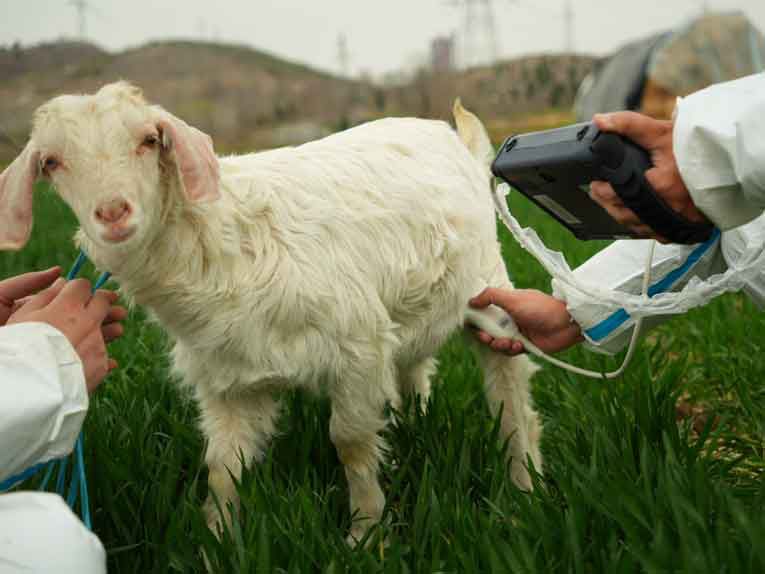In modern animal husbandry, improving reproductive efficiency has become one of the keys to the development of the sheep industry. In particular, seasonal fluctuations have become an important factor that cannot be ignored when monitoring the fertility of rams (breeding rams). Utilizing veterinary ultrasound equipment for systematic reproductive assessment of rams not only improves management efficiency, but also brings a more scientific decision-making basis for farms. In this paper, we will discuss the causes of seasonal reproduction in rams, the necessity of ultrasound technology in the reproductive detection of rams, and sheep ultrasound detection equipment has become a standard tool for modern livestock management.
I. Reasons for seasonal reproduction in rams
The reproductive cycle of rams is driven by the triple drive of the light cycle, temperature changes and endocrine regulation, and is mainly regulated by the time of light (photoperiod). In most sheep breeds, when daylight hours are shortened (i.e., in the fall), rams begin to enlarge their testes, improve sperm quality, and exhibit a reproductively active state; whereas in the spring and summer, testes shrink in size, spermatogenesis is reduced, and reproductive performance declines.
In addition, temperature, nutrition and management practices also affect the seasonal reproductive performance of rams. Temperature sensitivity: Cold environments (e.g., Australian winter) can prolong the spermatogenesis cycle. Hormonal fluctuations: Testosterone levels peak during the breeding season (October-December) and are positively correlated with semen quality.
II. The need for ultrasound technology for seasonal reproductive testing in rams
Traditional methods (e.g. rectal palpation, blood sampling) suffer from high invasiveness and data lag. Veterinary ultrasound is realized by real-time imaging:
Non-invasive monitoring of testicular volume: precise quantification of seasonal variations (e.g. Italian studies show that testicular volume in rams expands by 30% during the breeding season).
Semen quality assessment: prediction of sperm viability by scrotal blood perfusion.
Early warning of disease: identifying lesions that affect fertility such as orchitis and epididymal cysts.
What can ultrasound technology detect in rams?
Testicular volume changes: measuring the length, width and thickness of the testes by ultrasound and observing seasonal trends.
Testicular tissue echogenicity: ultrasound images reflect whether the testicular tissue structure is homogeneous, with or without degeneration, atrophy or lesions.
Blood flow test (Doppler function): to assess the blood supply to the reproductive organs, high blood flow is usually associated with better reproduction.
Epididymal and vas deferens status: to observe for obstruction, inflammation or abnormalities.
Indirect prediction of semen quality: The health of the testes and epididymis is closely related to semen quality, and ultrasound images can help in the initial determination.
III. Practice of ultrasound technology application in global animal husbandry countries
Traditional fertility assessment relies on manual observation or invasive sampling, which has drawbacks such as low efficiency, large errors and high stress. Veterinary ultrasound technology, with its non-invasive, real-time, high-resolution advantages, has become the focus of international animal husbandry research, farms can build from “individual health” to “group reproduction” intelligent management system. For example:
Research at Murdoch University in Australia shows that ultrasound can quantify testicular volume changes in rams and accurately predict sperm production (Animal Reproduction Science, 2021). A large breeding farm in Western Australia utilizes portable veterinary ultrasound machines to scan the testes of breeding rams quarterly, and combines them with AI algorithms to predict the optimal mating window, which has resulted in an increase in the conception rate of 22%.
New Zealand’s AgResearch facility optimized its seasonal breeding program by monitoring seminal vesicle gland development with ultrasound;
The use of ultrasound to assess prostate health at the University of Padua, Italy, significantly reduced culling rates due to reproductive inflammation, and the culling of rams with prostate abnormalities through ultrasound screening in Tuscany led to a 35% improvement in breeder herd health and a significant increase in offspring birth weight.
Research at the University of Cordoba, Spain, has confirmed that ultrasound blood flow imaging can dynamically track testicular vascularization levels and provide a basis for nutritional regulation, and Andalusian ranches have introduced a cloud-based ultrasound data platform to track the reproductive parameters of rams in different seasons in real time and optimize the deployment of cross-border germplasm resources.
These results confirm the core position of sheep ultrasound technology in the global livestock industry chain, and also lay a scientific foundation for the popularization of veterinary testing equipment.
IV. Why year-round monitoring is needed? Economic significance of breaking seasonal restrictions
Despite the seasonal peak in ram fertility, modern animal husbandry has gradually realized “year-round balanced production” through environmental control (e.g. artificial light, constant temperature sheep housing) and nutritional intervention. In this context, the value of veterinary ultrasound technology is further emphasized:
Precise control of the breeding cycle: by monitoring changes in testicular volume, breeding potential can be predicted 2-3 months in advance and breeding batches can be planned;
Reducing hidden costs: early detection of reproductive pathologies (e.g. fibrosis of seminal vesicle glands) to avoid culling of high-priced breeders due to untimely treatment;
Enhancing genetic resource utilization: combining ultrasound data to screen year-round high-activity breeding sheep, accelerating the spread of good genes.
As the livestock industry develops towards intelligence and precision, veterinary ultrasound equipment is becoming an indispensable tool for modern farms. In particular, ultrasound technology offers unprecedented ease and accuracy in tracking seasonal fluctuations in the reproductive system of rams. Whether in grassland livestock powerhouses such as Australia and New Zealand, or in sheep milk and meat sheep countries such as Italy and Spain, the use of ultrasound testing technology has significantly improved reproductive success.,the choice of different sheep ultrasound probes is based on measuring the body position of the sheepInvesting in an efficient sheep ultrasound machine is certainly a long-term solution worth considering for farmers looking for solutions to improve sheep productivity.
Post time: May-27-2025




